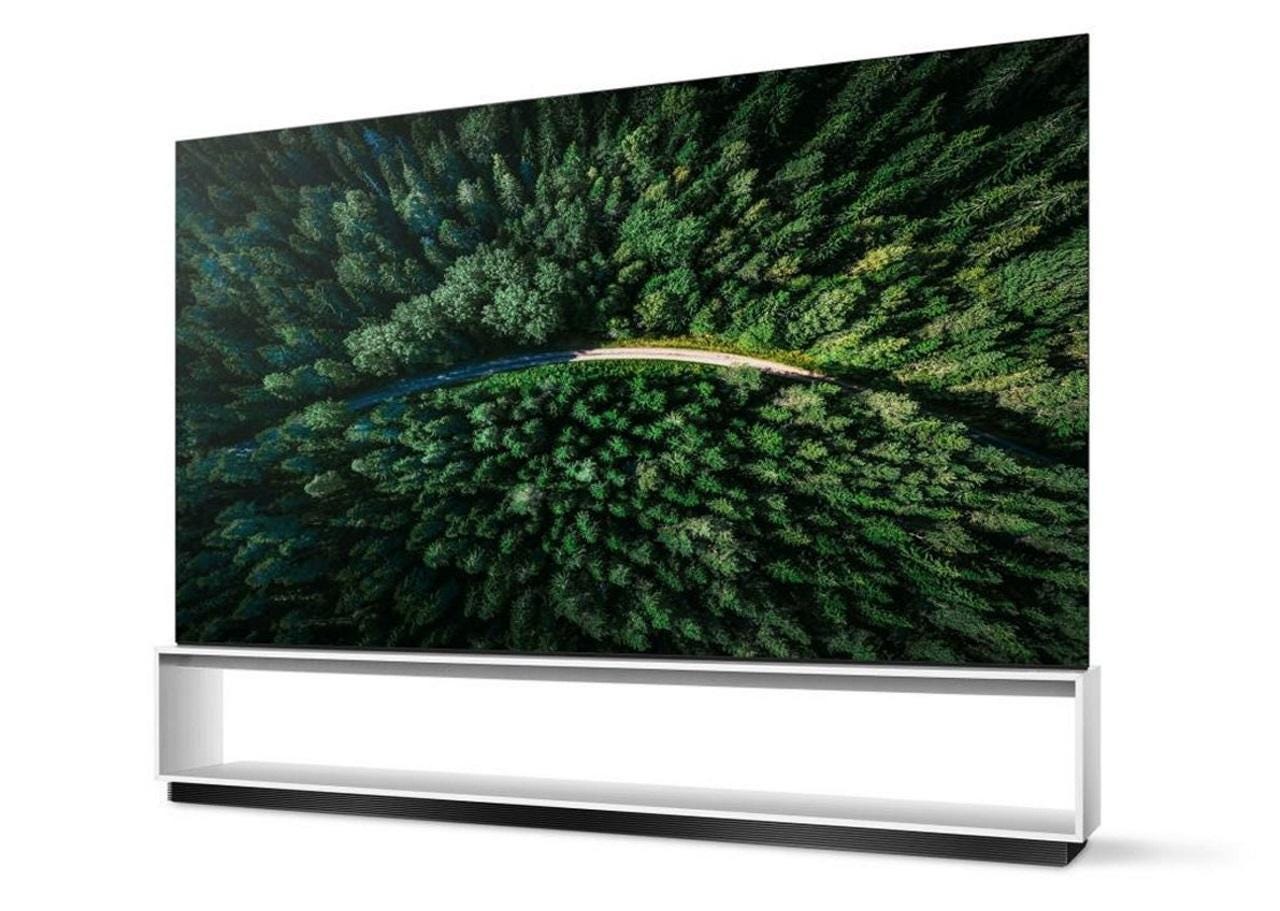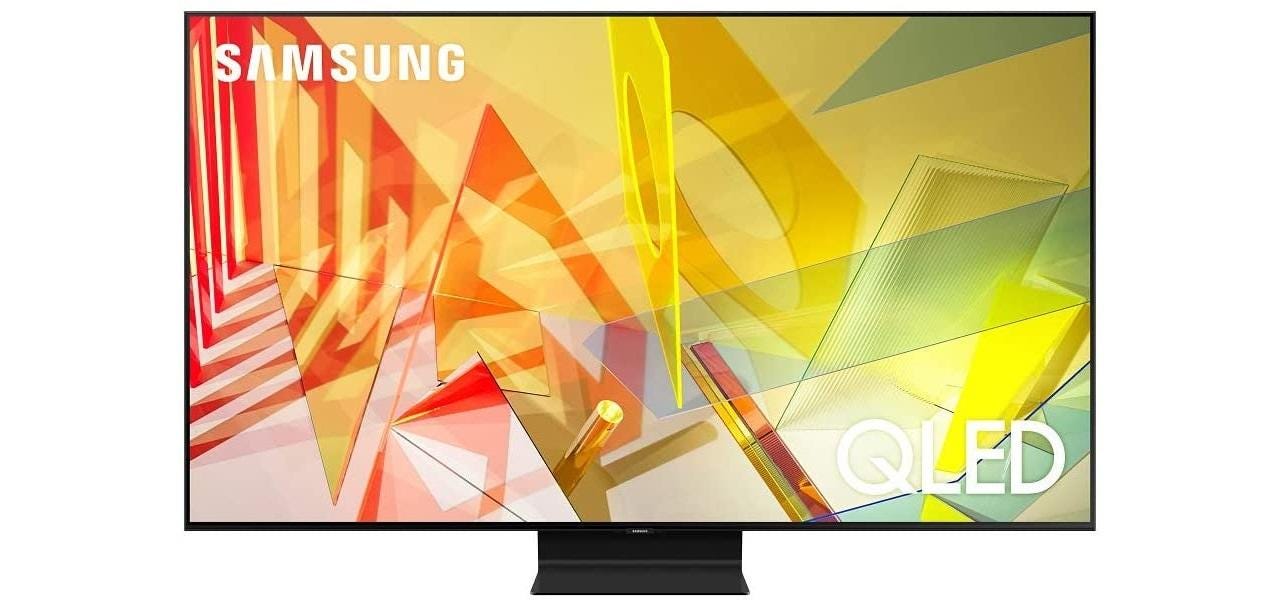qt qled_OLED与QLED:有什么区别?
qt qled
Samsung is promoting QLED panels for its high-end TVs, while LG is pushing organic light-emitting diode (OLED) for its flagship models. Which technology do you want in your next television? We explain.
三星正在为其高端电视推广QLED面板,而LG为其旗舰机型推有机发光二极管(OLED)。 您想在下一台电视中使用哪种技术? 我们解释。
By Will Greenwald
由 威尔·格林沃尔德
It’s starting to look like LED isn’t good enough anymore. The term (an abbreviation for light-emitting diodes) describes a now-standard method of lighting LCD televisions, to the point that most LCD TVs are now called LED TVs. In order to stand out, LG and Samsung have added letters to the term to carve out specific labels for their own high-end TVs. LG’s flagship TVs are OLED, while Samsung calls its top-end models QLED. They look and sound similar, but they’re very different technologies.
开始看起来LED不够好了。 术语(发光二极管的缩写)描述了现在点亮LCD电视的标准方法,以至于大多数LCD TV现在被称为LED TV。 为了脱颖而出,LG和三星在术语中添加了字母,以为其自己的高端电视雕刻出特定的标签。 LG的旗舰电视是OLED,而三星将其高端机型称为QLED。 它们看起来和听起来相似,但是技术却截然不同。
LCD与LED (LCD vs. LED)
Before we get into what makes them different, it’s important to understand what LED means. LED-backlit LCD TVs consist of two main parts: the panel and the backlight. The panel is an LCD (short for liquid crystal display) sheet that can produce images when electricity flows through it. The LCD generates the individual pixels of the TV, activating different combinations of red, green, and blue sub-pixels to produce the correct color for each pixel.
在研究使它们与众不同的原因之前,重要的是要了解LED的含义。 LED背光液晶电视包括两个主要部分:面板和背光。 面板是LCD(液晶显示器的缩写)板,当电流流过该板时可以产生图像。 LCD生成电视的各个像素,激活红色,绿色和蓝色子像素的不同组合以为每个像素产生正确的颜色。
LCDs don’t produce light, and without a backlight the pictures they form would be very difficult to see under most lighting conditions. That’s why LCD panels need to be backlit by separate light sources either behind or along the edges of the panel. On early LCD TVs, these lights were bulky cold-cathode fluorescent lamps (CCFLs), but in the past few years thinner, lighter, and more energy-efficient LED lighting systems have all but completely replaced them.
LCD不发光,如果没有背光,则在大多数照明条件下很难看到它们形成的图像。 这就是为什么LCD面板需要在面板边缘后方或沿边缘使用单独的光源进行背光照明的原因。 在早期的液晶电视上,这些灯是笨重的冷阴极荧光灯(CCFL),但在过去几年中,更薄,更轻,更节能的LED照明系统几乎完全取代了它们。
At their simplest, LED backlights just illuminate the LCD panel so you can see the picture it’s displaying. More advanced TVs use arrays of dimmable LEDs to make parts of the TV brighter or darker, improving the contrast of the picture. The more individually controllable LEDs in the array, the more the backlight can improve the TV’s contrast ratio and prevent halos and auras in the shadowy parts of high-contrast scenes.
最简单的说,LED背光仅照亮LCD面板,因此您可以看到其显示的图片。 更高级的电视使用可调光LED阵列使电视的部分更亮或更暗,从而改善了图像的对比度。 阵列中可单独控制的LED越多,背光可以提高电视的对比度,并防止高对比度场景的阴影部分出现光晕和光环。

LG和OLED (LG and OLED)
Organic light-emitting diode, or OLED, TVs sound like they should be very similar to LED TVs. After all, the letters are there, and they even mean the same thing. The logical conclusion from the term would be that OLEDs are just LEDs that have an organic component to them. That’s true in the most basic sense, but OLED displays are actually wildly different from LED-backlit LCD TVs.
有机发光二极管或OLED电视听起来应该与LED电视非常相似。 毕竟,字母在那里,它们甚至意味着同一件事。 从该术语得出的合理结论是,OLED只是具有有机成分的LED。 从最基本的意义上说,这是正确的,但是OLED显示器实际上与LED背光LCD电视有很大的不同。
OLED TVs use panels of OLEDs to both generate and illuminate the picture. Each pixel on an OLED panel is produced entirely by the OLEDs themselves, determining the color of that pixel and causing it to produce light. Mechanically, OLED displays are much closer to now-defunct plasma TVs, which consist of individual plasma cells coated with colored phosphors, determining both the color and the light of each pixel on a single panel. The chemistry, engineering, and physics of the two technologies are wildly different, but fundamentally they do the same thing: generate a picture that doesn’t require an external light source for illumination.
OLED电视使用OLED面板来生成和照明图片。 OLED面板上的每个像素完全由OLED本身产生,从而确定该像素的颜色并使其发光。 从机械上讲,OLED显示器更接近于现已淘汰的等离子电视,该电视由涂有彩色荧光粉的单个等离子电池组成,可确定单个面板上每个像素的颜色和光。 两种技术的化学,工程和物理学有很大的不同,但是从根本上说,它们做的是相同的:生成不需要外部光源照明的图片。
Because each pixel generates its own light, OLED panels can produce the best possible contrast of all display technologies. If part of the picture is black, those pixels can simply turn off and emit no light at all. This is a stark difference from LED lighting arrays for LCD panels, which always bleed some form of light to parts of the panel that should be unlit. Excellent LED TVs generate less than 0.01cd/m2 of light for black sections of the screen. OLED TVs produce no light at all for those same sections. This is why OLED TVs are often described as having “infinite” contrast-no matter how bright the screen can get, the black level is always zero.
由于每个像素都产生自己的光,因此OLED面板可以产生所有显示技术中最佳的对比度。 如果图片的一部分是黑色的,则这些像素可以简单地关闭并且完全不发光。 这与用于LCD面板的LED照明阵列有明显的不同,后者总是将某种形式的光散发到应该不照明的面板部分。 出色的LED电视在屏幕的黑色部分产生的光少于0.01cd / m2。 OLED电视在这些相同的区域根本不发光。 这就是为什么通常将OLED电视描述为具有“无限”对比度的原因-无论屏幕能获得多亮,黑电平始终为零。
OLED panels are very expensive to manufacture in large sizes, so OLED TVs are consistently pricey to match. This is why LG keeps OLED technology reserved for its very high-end TV models. The OLEDC9P series retails for $2,499 for 55 inches, though it can be found for less. On the other end, the 88-inch, 8K LG Signature OLED88Z9P is an eye-popping $29,999.99. This is why LG is one of the few major TV manufacturers to offer OLED TVs, though Sony also has some flagship OLEDs available, like the Master Series XBR-A9G ($2,799.99 for 55 inches).
OLED面板的大尺寸制造非常昂贵,因此OLED电视的价格始终很高。 这就是LG保留OLED技术用于其高端电视型号的原因。 OLEDC9P系列55英寸的零售价为2499美元,尽管价格更低。 另一方面,88英寸8K LG Signature OLED88Z9P的价格令人$目结舌的29,999.99美元。 这就是为什么LG是少数提供OLED电视的主要电视制造商之一的原因,尽管索尼还提供了一些旗舰OLED,例如Master Series XBR-A9G (55英寸2,799.99美元)。
While LG is the biggest name for OLED TVs, OLED technology is much more common in smaller form factors. OLED panels are consistently more expensive than LCDs, but the cost decreases significantly as panel sizes scale down. OLED displays are used in many high-end mobile devices, including Samsung’s own Galaxy S20 phones.
虽然LG是OLED电视的最大称号,但OLED技术在较小的外形尺寸中更为普遍。 OLED面板始终比LCD昂贵,但是随着面板尺寸的缩小,成本显着降低。 OLED显示器用于许多高端移动设备,包括三星自己的Galaxy S20手机。

三星的QLED (Samsung’s QLED)
Samsung’s flagship QLED TVs are, according to the company, comparable with OLED TVs. The terms even look similar, just with a little line coming out of the O to turn it into a Q. However, while Samsung QLED TVs might have very advanced technology in them, they’re still fundamentally LED-backlit LCD televisions.
该公司称,三星的旗舰QLED电视可与OLED电视媲美。 这些术语甚至看起来很相似,只是从O出来只有一点点就可以将它变成Q。但是,尽管三星QLED电视可能具有非常先进的技术,但从根本上说,它们仍然是LED背光LCD电视。
QLED TVs use LCD panels and LED backlight arrays, like many high-end LED TVs. The QLED descriptor is a Samsung marketing term that indicates several Samsung-specific enhancements to the TVs. To start, QLED TVs use Samsung’s Quantum Dots technology for its LCD panels. Quantum Dots are nanoparticles that emit or alter light at different frequencies when exposed to electricity. This light-tweaking can produce more precise color in a wider range than the LCDs illuminated by white LEDs can.
与许多高端LED电视一样,QLED电视使用LCD面板和LED背光阵列。 QLED描述符是三星的营销术语,表示对三星电视的若干特定增强功能。 首先,QLED电视将三星的量子点技术用于其LCD面板。 量子点是纳米粒子,当暴露于电时会发射或改变不同频率的光。 与白色LED照明的LCD相比,这种光导可以在更宽的范围内产生更精确的颜色。
A wider color gamut is very beneficial, but as an LED-lit LCD panel, QLED TV contrast is still a big concern-the technology doesn’t appear to produce the perfect black levels that OLED panels can. To improve contrast, QLED TVs are treated with a low-reflectivity finish while producing a peak luminance of 1,500 to 2,000cd/m2 according to Samsung. We’ll confirm whether or not QLED TVs can offer that sort of performance when we get them in the lab for full review.
更大的色域非常有益,但是作为LED照明的LCD面板,QLED TV对比度仍然是一个大问题-该技术似乎无法产生OLED面板可以达到的完美黑电平。 为了改善对比度,三星表示,QLED电视经过低反射率处理,同时产生了1,500至2,000cd / m2的峰值亮度。 当我们将QLED电视送到实验室进行全面审查时,我们将确认QLED电视是否可以提供这种性能。
QLED TVs are nearly as pricey as LG’s OLED TVs, but there is much more flexibility for different budgets. The excellent Samsung Q90R retails for $3,499.99 for the 65-inch model, but lower-end models like the Q60T can be found for as little as $799.99 for 55 inches.
QLED电视几乎与LG的OLED电视一样昂贵,但是对于不同的预算,它具有更大的灵活性。 出色的三星Q90R 65英寸型号的零售价为3,499.99美元,而低端型号(如Q60T)的55英寸型号的零售价仅为799.99美元。
For now, you should simply understand that QLED is not the same as or similar to OLED. It might make an excellent picture as well, but the two technologies are as far apart from each other as OLED and conventional LED-lit LCD TVs.
现在,您应该只了解QLED与OLED不同或相似。 它也可能产生出色的图像,但是这两种技术与OLED和传统的LED照明LCD电视相距甚远。
两者的主要功能 (Big Features for Both)
Since OLED and QLED are technologies for flagship televisions, OLED and QLED TVs are equipped with all of the features expected of top-end models. Specifically, both TV types have 4K resolution and support HDR content.
由于OLED和QLED是旗舰电视的技术,因此OLED和QLED电视具备高端机型所期望的所有功能。 具体来说,两种电视都具有4K分辨率并支持HDR内容。
Ultra high-definition ( UHD, or 4K) is the current standard for consumer television resolution. 4K TVs are 3,840 by 2,160, displaying four times as many pixels as 1080p TVs. Most major TV manufacturers have all but replaced their 1080p TVs with 4K models, with the exceptions of some low-end budget TVs. If you buy a new, brand name TV larger than 40 inches this year, it will likely be 4K.
超高清( UHD或4K )是当前消费者电视分辨率的标准。 4K电视为3,840 x 2,160,显示像素是1080p电视的四倍。 除一些低端廉价电视外,大多数主要电视制造商几乎都将其1080p电视替换为4K型号。 如果您今年购买新的品牌电视大于40英寸,则可能是4K。
8K is also coming, and LG and Samsung are working on those TVs too, but don’t worry about it for now; native 8K content isn’t anywhere close to available to consumers. Even if you get an 8K TV, whether it’s OLED or QLED, you’ll be relying on upconverted 4K and lower-resolution content for a few years.
8K也即将到来,LG和三星也正在开发这些电视,但现在不必担心。 原生8K内容并不是消费者所能接近的。 即使您使用的是OLED或QLED的8K电视,几年也将依靠上转换的4K和较低分辨率的内容。
High dynamic range ( HDR) is a series of video standards that let TVs display a wider range of color and light than standard dynamic range video. HDR video comes in two major standards, HDR10 and Dolby Vision, with a few new standards and variants coming out recently. HDR10 is the format used with Ultra HD Blu-ray discs, and both LG OLED and Samsung QLED TVs can display them. While Samsung TVs don’t support Dolby Vision, most streaming services that offer HDR content in Dolby Vision also support HDR10, and supports the Samsung-developed HDR10+ format, which is more advanced than standard HDR10.
高动态范围( HDR )是一系列视频标准,可以使电视显示比标准动态范围视频更广泛的色彩和光线范围。 HDR视频有两个主要标准,即HDR10和杜比视界(Dolby Vision),最近又推出了一些新的标准和变体。 HDR10是超高清蓝光光盘使用的格式,LG OLED和三星QLED电视都可以显示它们。 尽管三星电视不支持Dolby Vision,但大多数以Dolby Vision提供HDR内容的流媒体服务也支持HDR10,并且支持三星开发的HDR10 +格式,该格式比标准HDR10更高级。
Of course, both types of TVs are also fully connected, smart TVs that support streaming video services and apps. LG smart TVs use webOS, while Samsung TVs use the company’s Smart Hub interface. Both are connected platforms developed internally by their respective manufacturers, and both support all major 4K, HDR streaming services.
当然,两种类型的电视也都是完全连接的,支持流视频服务和应用程序的智能电视。 LG智能电视使用webOS,而三星电视使用该公司的Smart Hub界面。 两者都是各自制造商内部开发的互联平台,并且都支持所有主要的4K,HDR流媒体服务。
For more, head over to our latest reviews and check out the top TVs we’ve tested.
有关更多信息,请访问我们的最新评论并查看我们测试过的顶级电视 。
Originally published at https://www.pcmag.com.
最初发布在 https://www.pcmag.com 。
翻译自: https://medium.com/pcmag-access/oled-vs-qled-whats-the-difference-4db1cb7ea3ec
qt qled
http://www.taodudu.cc/news/show-4617529.html
相关文章:
- 【原】Coursera—Andrew Ng机器学习—课程笔记 Lecture 5 Octave Tutorial
- 量化投资实战(三)之配对交易策略---协整法
- octave-移动数据
- 吴恩达 octave
- 机器学习吴恩达第二周
- matlab版吴恩达机器学习第五章笔记
- This program may be freely redistributed under the terms of the GNU GPL
- INKSCAPE (Draw freely) pdf转eps
- linux中yum provide,Liunx 安装YUM有没有详细的教程。
- free ebooks: http://stackoverflow.com/questions/194812/list-of-freely-available-programming-books
- linux修复模式rpm,修复rpm命令(不小心删了rpm命令)方法
- Pro*C环境搭建
- centos7 添加开机自启动
- MIMIC-III数据库的介绍
- Python-入门学习
- 2020-2-10新生赛
- 执行rpm -Uvh xxxxxx.rpm, 报freely redistributed under the terms of the GNU GPL
- list of freely available programming books
- 计算机专业免费电子书下载列表List of freely available programming books
- Robust Visual Tracking with a Freely-moving Event Camera
- Linux系统中rpm命令安装软件,报错:This program may be freely redistributed under the terms of the GNU GPL
- Freely Available Standards
- Java实现简易计算器
- 简易内存池
- 简易计算机
- JavaScript实现简易ATM
- 简易绘图程序
- 实现简易HTTP服务器
- mysql查询未讲课教师_MySQL基础(查) - osc_hghvwmhn的个人空间 - OSCHINA - 中文开源技术交流社区...
- VScode跑街商场网页排版
qt qled_OLED与QLED:有什么区别?相关推荐
- Qt 中static_cast 和 reinterpret_cast的区别
Qt 中static_cast 和 reinterpret_cast的区别 1. C++中的static_cast执行非多态的转换,用于代替C中通常的转换操作.因此,常做为隐式类型转换使用.比如: i ...
- Qt: MinGW 与MSVC的区别
Qt 中有两种方式编译:一种是MinGW ,另一种MSVC,是两种不同的编译器. 1.MSVC是指微软的VC编译器 2.MingGW是指是Minimalist GNU on Windows的缩写.它是 ...
- QT QTransform与QMatrix 有啥区别?
刚开始学习QT,我使用的是QT5.12进行开发,要不时地查阅QT的官方帮助文档~ 仔细阅读QT官方帮助QTransform类以及QMatrix类,发现两个类的作用描述一模一样("The QT ...
- Qt中update()和repaint()的区别
转载:https://blog.csdn.net/qq_35396127/article/details/77745204 解释1 voidQWidget::repaint ( int x, int ...
- Qt 可见性 isHiden和isVisible的区别
之前一直对isHiden和isVisible的区别比较模糊,都是乱用的.今天因需要仔细看了一下. 1.isHiden只是返回部件的隐藏属性,并不能表示部件当前的真实状态.比如A部件有个子部件B,而A处 ...
- qt repaint 用法_关于Qt 中update()和repaint()的区别
void QWidget::repaint ( int x, int y, int w, int h, bool erase = TRUE ) [槽] 通过立即调用paintEvent()来直接重新绘 ...
- QT 中QTimer 和 startTimer()的区别
最需要注意一点 请注意,QTimer的准确性取决于底层操作系统和硬件.timerType参数允许您自定义计时器的准确性.有关不同计时器类型的信息,请参见Qt::TimerType.大多数平台支持20毫 ...
- create和qypt qt_pyqt 与 qt c++ 开发windows客户端程序区别
我建议你可以从下面方面衡量你应该如何选型 1) 该客户端是否"比较复杂",也就是说代码量是否比较多,如果代码量比较多的话,反而建议你上Qt,因为Python语言代码量上去的话,还要 ...
- [QT]clicked(bool)与toggled(bool)区别
toggled(bool) 会对 setChecked(bool) 接受信号 调用槽函数 clicked(bool)不会
最新文章
- ListT随机返回一个
- 机器学习性能优化全解
- java swing 右键_java swing制作右键菜单
- php 如何实现无状态化,服务无状态化设计分析
- 利用深度学习方法进行情感分析以及在海航舆情云平台的实践
- mysql 1.42_MySQL索引(一)
- OA+CRM+ERP
- Skyline软件二次开发初级——5如何在WEB页面中的三维地图上使用事件函数
- 正弦波表(应该还会补充)
- 十三种常用的数据挖掘的技术
- SQL注入风险高,手写 SQL 须谨慎
- w ndoWs8pE模式下载,windows pe官方版下载_windows pe v8.2 - Win7旗舰版
- 别被你的双眼所欺骗 100张神奇的视觉欺骗图
- 【JZOJ A组】Melancholy
- Don’t Miss the Labels: Label-semantic Augmented Meta-Learner for Few-Shot Text Classification
- UWB定位系统在展馆中的应用
- hive的一些常用命令
- 一文搞懂Qt中的颜色渐变(QGradient Class)
- Android中Alarm的机制
- ACCESS实例2 资料管理2——窗体创建方法
